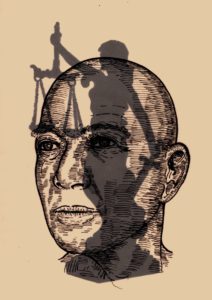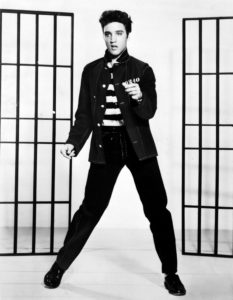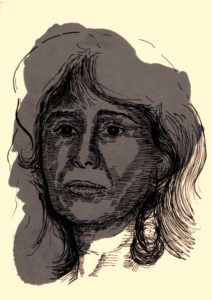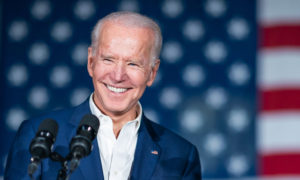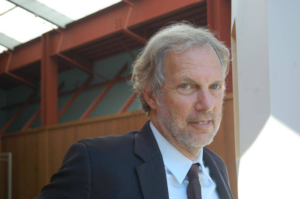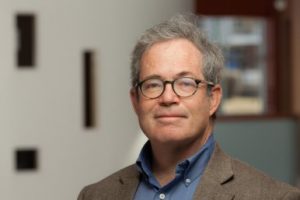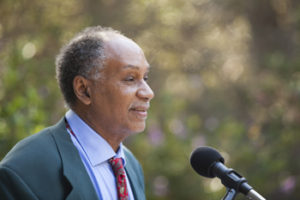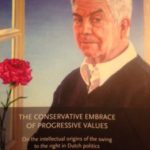Tommy Wieringa – Gedachten over onze tijd
Tommy Wieringa (1967) schrijft wekelijks voor NRC Handelsblad over de actualiteit in een periode van grote veranderingen en onzekerheden; het sociale weefsel rafelt.
Het zijn artikelen over autoritaire populisten, het toenemende fascisme en nationalisme, nepnieuws, de vrijheid van denken, de gevolgen van de klimaatcrisis, het coronavirus dat het speelveld drastisch herschikt en de urgentie van cultuur. Maar hij schijft ook over zijn dochters en literaire ontmoetingen in het buitenland. Tommy Wieringa legt verbanden met het verleden en doet een bewogen, moreel appel op de lezers.
Er zijn artikelen over Europa, een continent dat van crisis naar crisis ‘hompelt’, en waar het fascisme langzamerhand een courante Europese stroming wordt, en Wieringa tot een vermoeide Europeaan maken. Hij beschrijft het verontrustende nepnieuwsbericht van de NOS over de jood George Soros ‘een invloedrijke bemoeial met tentakels ver in de wereldpolitiek’ dat zelfs door de journalisten niet als zodanig was herkend en gebruik maakt van fascistische taal. Je hoeft niet eens meer een hekel aan joden te hebben om antisemitische quatsch te produceren, aldus Wieringa.
Tommy Wieringa gaat in diverse artikelen in op het asielbeleid en vluchtelingen, zoals de wandeltocht vanuit herinneringscentrum Kamp Westerbork tijdens de Nacht van de Vluchtelingen die niet doorging vanwege bedreiging door vluchtelingenhaters en de joodse gemeenschap. En ondertussen gaat de versobering van de asieladvocatuur gewoon door.
Over de vijfentwintighonderd verdwenen kinderen, een kwart van alle alleenstaande minderjarige asielzoekers, waar ze gebleven zijn weten we niet. ’Met onbekende bestemming vertrokken, staat er achter hun naam.’ Zijn ze doorgereisd naar familie elders in Europa, gevallen in de handen van mensenhandelaren? Verdwenen in de criminaliteit, prostitutie, of in het illegale arbeidscircuit? Maar het zijn onze kinderen niet, en daarmee niet onze zorg.
Diverse artikelen zijn gewijd aan Thierry Baudet en Wilders die niet direct oproepen tot geweld, ‘maar (ze) scheppen een sfeer waarin geweld tegen een zogenaamd inferieure minderheid wordt vergoelijkt, en de geesten worden rijp gemaakt voor uitdrijving.’ Kritische artikelen over Baudet als bewonderaar van zijn leermeester Roger Scruton, en van Vladimir Poetin, en ontkenner van de klimaatcrisis.
In de wetenschap zou Baudet worden weggehoond, maar in de politiek vormen halve waarheden en hele leugens zijn politieke kapitaal., aldus Wieringa.
De urgentie en rol van de cultuur komen ook aan bod. Onder andere naar aanleiding van het commentaar van Clarice Gargard op de tentoonstelling ‘Vrijheid’ in de Fundatie in Zwolle. Gargard constateert culturele toe-eigening, bijvoorbeeld in de foto’s van Viviane Sassen, omdat ze de zwarte mens gereduceerd ziet tot zijn huidskleur. Maar juist zijzelf reduceert de zwarte mens tot zijn huidskleur, aldus Wieringa, zo zorgt zijzelf voor munitie in de identiteitsoorlog die op dit moment wordt gevoerd. Wieringa: ‘De cultuur zelf is intussen van niemand. Wij zijn allen gebruikers, geen eigenaars. Iedereen speelt altijd en overal leentjebuur. Je kunt cultuur koesteren, vereren, misvormen, verwoesten of onherstelbaar verbeterd teruggeven, maar je eigendom is het niet.’
Hij wijst op de naïviteit van mensen, en het ontbreken van weinig historisch besef. Als voorbeeld verwijst Wieringa naar Daan Roosegaarde, die door het Nationaal Comité 4 en 5 mei was uitgenodigd een ontwerp te maken. Hij ontwierp ‘Levenslicht’ met lichtgevende steentjes, honderdvierduizend, een voor elk individu dat naar de concentratiekampen werd afgevoerd, zonder een enkele verwijzing te leggen naar het ‘Stolpersteine’ project van de Duitse kunstenaar Demnig. Daan Roosegaarde begeleidde zijn ontwerp met de woorden ‘Ze wisten niet wat ze te wachten stond, maar ze voorvoelden dat het weinig goeds was.’ En ‘In de wagon sijpelde licht naar binnen door een kier in de deur. Dat zagen ze als teken van hoop.’ Zo kwam Roosegaarde op het idee om iets met licht te doen. Dunne ideetjes, lolletjes voor de openbare ruimte, aldus Wieringa.
En diverse artikelen gaan over de desastreuze effecten van de klimaatcrisis, hier nog beperkt ‘tot het verdwijnen van vogels en insecten, ongekende droogte verzakkende huizen, maar elders zijn de effecten al desastreus met onophoudelijke natuurbranden, hittegolven, tornado’s, overstromingen en misoogsten.‘ Tommy Wieringa waarschuwt ons dat de klimaatcrisis zal leiden tot migratiestromen die in het Westen een destructief wantrouwen zullen veroorzaken in supranationale organisaties als de Europese Unie.
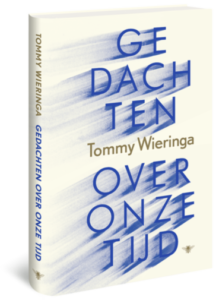 Vanzelfsprekend is er ook veel aandacht voor de corona crisis. De rol van Mark Rutte en het RIVM worden belicht, de anderhalve meter afstand, de virus-industrie, de invloed van het virus op onze toekomst, complotdenkers.
Vanzelfsprekend is er ook veel aandacht voor de corona crisis. De rol van Mark Rutte en het RIVM worden belicht, de anderhalve meter afstand, de virus-industrie, de invloed van het virus op onze toekomst, complotdenkers.
Het laatste artikel is gewijd aan de inauguratie van Joe Biden als 46ste president van de Verenigde Staten, die Tommy Wieringa onverwacht sterk raakte vanwege de herstelwerkzaamheden van democratie en rechtsstraat. Maar de toeslagenaffaire in Nederland laat zien dat je geen autocraat nodig hebt om democratische en rechtsstatelijke principes te ondermijnen.
Tommy Wieringa – Gedachten over onze tijd. Amsterdam, De Bezige Bij, 2021. ISBN 9789403123912
Tommy Wieringa is de auteur van onder meer Joe Speedboot, De dood van Murat Idrissi en De heilige Rita. Zijn werk is in meer dan twintig landen vertaald.
Linda Bouws – St. Metropool Internationale Kunstprojecten
De Walrus of Love en de King of Rock: opmerkelijke bijnamen in de popmuziek
Ella Fitzgerald is the First Lady of Song, Aretha Franklin heet the Queen of Soul, Chuck Berry is the Father of Rock and Roll en Michael Jackson is bekend als the King of Pop: in de wereld van de jazz en popmuziek is aan bijnamen waarlijk geen gebrek. Meestal zijn die, zoals hierboven geïllustreerd, voor de hand liggend en weinig geïnspireerd. Verfrissend is het daarom op een ongebruikelijke, originele of anderszins verrassende bijnaam te stuiten.
Een mooi voorbeeld is die voor de omvangrijke Amerikaanse zanger Barry White (1944- 2003). Zijn toegewijde fans noemen hem vertederd the Walrus of Love. En inderdaad, wie een paar foto’s van de zingende zeerob meer dan vluchtig bekijkt, kan enige gelijkenis niet ontgaan.
Het love-deel van deze eretitel verwijst naar het diep-bronzen stemgeluid – in vaktermen: een driedubbele bas -, waarmee hij nummers als You’re the first, the last, my everything, Never never gonna give ya up en Let the music play voor zich uit bromt.
Barry White, geboren als Barry Carter en toen nog van normaal gewicht, kruiste eens op onverwachte wijze mijn pad. Voor het radioprogramma Het Zout in de Pap maakte ik literaire portretten van een uur. De gesproken delen werden afgewisseld met muziekfragmenten, waarvoor ik gewoonlijk de geïnterviewde auteur naar een voorkeur vroeg. In 1992 maakte ik zo’n portret van Bas Heijne naar aanleiding van zijn toen jongste roman Suez. Op mijn vraag naar een muzikale wenslijst bekende hij zijn liefde voor het werk van White. In diezelfde periode trad de zwoel zwijmelende zwaargewicht op in Rotterdam en zo kon het gebeuren, dat er van Bas Heijne, toen nog niet de huisfilosoof van het NRC/Handelsblad, naast zijn opiniërende stukken een interview met Barry White verscheen.
Het beste voorbeeld, evenwel, is Elvis Aaron Presley (1935-1977). Of Aron, zoals zijn ouders hem genoemd hadden. De dokter die aangifte deed, gaf echter de meer gangbare spelling – met dubbel A – op en zo staat het ook op zijn grafsteen.
De naam Elvis dankt hij aan de middelste naam van zijn vader, Vernon Elvis Presley. Een weinig gangbare naam, behalve onder de arme blanke bevolking in het zuiden.
Het beste voorbeeld om meer dan één reden. Niet zozeer vanwege zijn gangbare bijnamen, zoals the Mississippi Flash, omdat hij werd geboren in Tupelo in de staat Mississippi -, of the Memphis Flash. Hij overleed immers in Memphis, Tennessee. Graceland, zijn woonhuis en landgoed daar, is sindsdien meer dan een Elvis-museum. Het is een bedevaartsoord. (Ter contrastering: het Nederlandse Elvis Presley-museum is te vinden in een antiekboerderij in Molkwerum, in de provincie Friesland.) Of neem, als cliché aller clichés, the King.
Maar wel om het onwaarschijnlijke toeval dat zijn voornaam perfect rijmt op pelvis, naar het Latijnse pelvis voor bekken. En laten nu de ritmisch schokkende bewegingen met zijn bekken typerend zijn voor Elvis’ manier van bewegen op ritmische muziek.
Met die weinig verhullende maar alles suggererende bewegingen lag de bijnaam Elvis the Pelvis al snel voor de hand. Wellicht onbedoeld effect van dat heftige geschok was, dat de gezagsgetrouwe ouders van voornamelijk blanke kinderen met lede ogen aanzagen hoe die kinderen niet alleen die bewegingen overnamen – niet voor niets werd dat al snel rock-and-roll genoemd, zeer vrij te vertalen als heen-en-weer-en-op en-neer -, maar ze in toenemende mate zelfs op ideeën bracht.
Een eveneens interessante maar wat onderbelicht gebleven reden is de invloed die het verschijnsel Elvis, afgezien natuurlijk van zijn muziek, had in de popmuziek, bijvoorbeeld op het gebied van namen.
Enkele opmerkelijke voorbeelden. De Amerikaanse zanger Martin Benefield had als Vince Everett een paar bescheiden hits. Zijn pseudoniem had hij geleend van het door Elvis gespeelde personage in diens eerste grote speelfilm, Jailhouse Rock (1957). De Londense band The Sid Presley Experience putte voor zijn naam zelfs uit drie popbronnen: Sid Vicious, frontman van The Sex Pistols, Elvis Presley en The Jimi Hendrix Experience.
Reginald Maurice Ball, kortweg Reg Ball, was de zanger van de Britse groep The Troggs, maar had volgens zijn manager Larry Page niet echt de naam van een popster. Als grap opperde Page de naam Presley en sindsdien heette de zanger Reg Presley.
The Troggs hadden tussen 1966 en 1968 wereldhits met Wild thing (“you make my heart sing”), With a girl like you en Love is all around, maar hadden daarvoor wel hun oorspronkelijke naam, Ten Foot Five, veranderd. Trogg was de verkorte vorm van troglodyte ofwel grotbewoner en was destijds gangbaar als scheldnaam voor het meer suffe type medemens. In 1967 verscheen hun album Trogglodynamite.
Ook de Engelse zanger Declan Patrick Aloysius McManus voorzag geen grootse carrière met zijn eigen naam. Toen hem een platencontract werd aangeboden waarin de voorwaarde was opgenomen dat hij een commerciëler artiestennaam zou nemen, viel de keuze op de meest commerciële voornaam die hij kon bedenken.
De achternaam Costello lijkt een verwijzing naar Lou Costello, de komische helft van het Amerikaanse duo Abbott and Costello, wereldberoemd vanwege hun dialoog Who’s on first?
In werkelijkheid was Costello de meisjesnaam van zijn moeder en was de voornaam van the King of Rock een idee van zijn manager, Jake Riviera. Dat pakte nog bijna ongelukkig uit, toen Costello’s eerste album, My aim is true, uitkwam rond het overlijden van Elvis Presley op 16 augustus 1977 en hij beschuldigd werd van lijkenpikkerij.
En voor de volledigheid: in 1986 bracht hij een album uit met de titel The King of America.
–
Robert-Henk Zuidinga (1949) studeerde Nederlandse en Engelse Moderne Letterkunde aan de Universiteit van Amsterdam. Hij schrijft over literatuur, taal- en bij uitzondering – over film.
De drie delen Dit staat er bevatten de, volgens zijn eigen omschrijving, journalistieke nalatenschap van Zuidinga. De boeken zijn in eigen beheer uitgegeven. Belangstelling? Stuur een berichtje naar: info@rozenbergquarterly.com– wij sturen uw bericht door naar de auteur.
Dit staat er 1. Columns over taal en literatuur. Haarlem 2016. ISBN 9789492563040
Dit staat er II, Artikelen en interviews over literatuur. Haarlem 2017. ISBN 9789492563248
Dit staat er III. Bijnamen en Nederlied. Buitenlied en film, Haarlem 2019. ISBN 97894925636637
Mardjan Seighali met Job Hulsman – Tot op de dag
‘Wie in het buitenland opnieuw begint moet zich bewijzen.’
Mardjan Seighali (1964) is geboren in de Iraanse plaats Rasht, waar ze een liberale opvoeding genoot; religie speelde geen rol.
Als scholiere maakte ze mee dat Iran in opstand kwam tegen de exorbitante levensstijl van de Sjah en hem tot aftreden dwong. De Iraanse ayatollah Khomeini kwam terug uit zijn tijdelijke verblijfplaats in Parijs en werd als held onthaald. Hij won de verkiezingen en veranderde Iran in een theocratisch bolwerk.
Mardjan Seighali sloot zich aan bij de Iraanse oppositiepartij Mojahedin-e Chalgh, de Volksmoedjahedien, een partij die streefde naar een meer gelijke welvaartsverdeling. Twee jaar later, in 1981, werd de partij door Khomeini tot vijand van god verklaard. Ze werd voor haar veiligheid door haar vader ontvoerd naar een tante in Teheran.
Als ze tussentijds haar familie bezoekt voor het nieuwjaarsfeest, wordt ze door de Revolutionaire Garde opgepakt, en wordt in de gevangenis, gemarteld, bedreigd en vernederd. Haar wordt niets bespaard omdat ze voor de partij pamfletten uitdeelde en deelnam aan discussies. Veel van haar medegevangenen eindigen in een massagraf, zoals haar vriendin Tahmina ‘een bloem die niet tot bloei mocht komen.’ Haar ouders sloten een deal met het regime waardoor ze na anderhalf jaar uit de gevangenis werd ontslagen, op voorwaarden dat ze moest trouwen en ze kreeg een studieverbod. Vlak na haar vrijlating trouwt ze, met tegenzin, met Rasoul: ze wilde vrij zijn, maar de eer van de familie was zo gered. Ze krijgt met hem twee zonen.
Mardjan Seighali was woedend omdat ze geen enkele inspraak had gehad op haar vrijlating; thuis mag ze nergens over praten.
Ze wil voor alles onafhankelijk zijn en vol strijdlust, ook in haar relatie met haar man Rasoul. Het is voor haar heel moeilijk over haar persoonlijke ervaringen te vertellen. Ze memoreert vaak de woorden van haar vader, toen ze vrijkwam uit de gevangenis: ‘Hier praten we niet meer over!’
Haar man Rasoul was in 1989 gevlucht naar Nederland, omdat hij gezocht werd vanwege een filmopname van een steniging. Mardjan Seighali wordt vervolgens herhaaldelijk opgepakt en weer vrijgelaten. Ze komt als zesentwintigjarige, na een aantal mislukte vluchtpogingen, met haar twee kinderen in 1990 in Nederland terecht waar ze weer moeizaam een gezin vormt met Rasoul, eerst in Den Helder, dan in Brummen en uiteindelijk in Almere, waar ze zich thuis voelt: ‘Almere – nieuwe stad waar je als nieuwkomer een nieuw leven kan beginnen.’
Ze worstelt nog steeds met haar herinneringen aan de gevangenis en het regime van ayatollah Khomeini, maar eenmaal in Nederland besluit ze alles op alles te zetten om haar leven weer betekenis te geven.
In 1997 voltooide ze haar studie Maatschappelijk werk- en dienstverlening aan de Hogeschool van Amsterdam. Later werd zij o.a. directeur van Stichting voor Vluchteling-Studenten UAF (die ook haar studie financierde), zat in de Raad van Advies College voor de Rechten van de Mens en krijgt een baan als hoofd Sector Communicatie & Publicatie en Relatiemanagement bij Stichting Erfgoed Nederland. Sinds november 2020 is ze voorzitter van het Humanistisch Verbond.
Schrijver en journalist Job Hulsman van uitgeverij Ambo/Anthos, die in 2017 Iran bezocht, weet haar te enthousiasmeren haar verhaal op te schrijven. Ze ontmoetten elkaar regelmatig aan haar keukentafel in Almere, en ook zelf kroop ze achter haar computer.
Na de lancering van Tot op de dag weet ze niet of ze blij is, want ze denkt nog steeds aan de mensen die in onvrijheid woonden en wonen. Sinds haar vrijlating in 1983 vraagt ze zich nog steeds af: ’is het een straf of een zegen dat ik vrijkwam? Als er iets te kiezen viel, wat zou ik dan hebben gekozen: thuiskomen met de herinneringen die ik heb en daarmee door het leven gaan of helemaal niet meer thuiskomen? De vragen galmen nog steeds door mijn hoofd.’
Mardjan Seighali met Job Hulsman – Tot op de dag – Ambo/Anthos Uitgevers, Amsterdam, 2021. ISBN 9789026353291
Opnieuw beginnen: Mardjan Seighali bij TEDxAlmere
Linda Bouws – St. Metropool Internationale Kunstprojecten
Biden’s $1.9 Trillion Stimulus Is A Vital Beginning For A New New Deal
In his first three days in office, President Joe Biden signed no less than 30 executive orders and memorandums, many of which dismantle Trump’s policies. This is an impressive achievement by any standard, but only so much can be done with executive orders and it is all but certain that most legislation will be blocked by Republican senators, thanks to filibuster, and with the possible help of some Democrats. In the meantime, Biden has proposed a $1.9 trillion stimulus for the coronavirus-hit economy which includes, among other things, a third relief check, extending unemployment benefits, setting aside $400 billion for a nationwide vaccine program, expanding the child tax credit and raising the minimum wage to $15 per hour. One could say that Biden’s economic plan is inspired by FDR’s New Deal because nothing like it has ever been introduced during peacetime. But what exactly does this economic plan mean for households, for business and for climate change? What will be the impact of the stimulus on public debt? And what about reforms for the financial sector, which continues to reap huge profits when millions of Americans are struggling? Two progressive economists, Robert Pollin and Gerald Epstein, co-directors of the Political Economy Research Institute at the University of Massachusetts at Amherst, address some of these questions in an exclusive interview for Truthout.
C.J. Polychroniou: Bob, the pandemic, in addition to having killed more than 400,000 Americans so far, thanks to Trump’s reckless response, has had a severe impact on the U.S. economy: business closures, massive unemployment, huge decline in the gross domestic product, increase in multiple kinds of inequality. Obviously, with those disturbing realities in mind, Joe Biden has released an economic plan to combat COVID-19 and get the country back on track which, according to many analysts, is inspired by FDR’s New Deal. Can you talk a bit about Biden’s economic plan and offer your assessment with specific reference to how it will support individuals, households and business through the pandemic?
Robert Pollin: The Biden administration has introduced a $1.9 trillion short-term economic stimulus program. It targets six main areas of spending: $1,400 in cash payments for people whose income is less than $75,000; $400 per week in supplemental unemployment insurance for laid-off workers; major support for state and local governments that are right now staring, collectively, at budget deficits of $500 billion or more; a major increase in spending on distributing COVID vaccines; and expanding the tax credit for families with children.
The total package amounts to about 9 percent of the economy’s overall level of activity — i.e., gross domestic product (GDP). This proposed Biden stimulus would also be on top of the $900 billion measure — equal to about 4 percent of GDP — that Congress and the Trump administration passed in December, as well as the $2 trillion package — equal to 10 percent of GDP — that was implemented last March. So, if the Biden proposal passes, it would mean that over the past 10 months, the federal government stimulus would add up to roughly 23 percent of GDP. And on top of that, since March, the Federal Reserve has purchased over $3 trillion in bonds — a 74 percent increase over their holdings as of last February — from Wall Street firms to bail them out and to keep pushing interest rates down on home mortgages, business loans and government bonds.
Overall, this level of economic stimulus since the COVID pandemic spread last March — which would amount to more than one-third of total GDP if the Biden proposal passes — has been historically unprecedented during peacetime. The only comparable level of government intervention was during World War II, when government deficit spending reached as high as 25 percent of GDP. But, of course, that spending was focused on fighting a world war.
The point, however, is that this level of public spending included in the current Biden proposal is absolutely necessary and, for that matter, will not be sufficient given the severity of the current economic crisis. Over the past nine months, 74 million people have filed to receive unemployment insurance. This is equal to fully 45 percent of the U.S. labor force. Meanwhile, as of the most recent data, nearly 20 percent of all U.S. households with children report that their families didn’t have enough to eat over the past week. That figure rises to 24 percent for African American households. Similarly, 26 percent of households with children report that they are unable to keep up with their rent. Amid all this, the Dow-Jones Industrial Average stock market index is up an incredible 68 percent since the initial stimulus program passed in March, thanks to both the stimulus and the Fed bailout having successfully propped up Wall Street.
Combating climate change seems to be one of the central objectives of Biden’s administration. How does Biden’s plan compare to the Green New Deal, especially the version of a “green economy” you have been fighting for over a decade now?
Pollin: The combined government spending injections since last March — totaling to roughly one-third of all spending in the economy if the current Biden proposal passes — don’t include a single dime to address the climate crisis. This is while we now know that 2020 was the second-hottest year on record. Biden has emphasized that he is going to take major action to address the climate crisis. Specifically, he has said that he will introduce a huge public investment-led program soon, that will be over and above the short-term stimulus measure to fight COVID and the ongoing recession.
On Wednesday, Biden signed a series of executive orders that will, among other things, suspend oil and gas leasing on federal government lands, transition the federal government’s stock of automobiles and trucks to an all-electric fleet, and create an Environmental Justice commitment in federal policies that will “address the disproportionate health, environmental, economic and climate impacts on disadvantaged communities.” Most broadly, Biden’s climate directive commits his administration to move the U.S. onto “an irreversible path to a net-zero economy by 2050.”
Nevertheless, for the most part, Biden has still not laid out his full-scale program for achieving the net-zero emissions goal. For now, we still need to look at what Biden proposed during the presidential campaign as a guide. That included both some positive as well as some seriously negative points. On the positive side, first, the overall level of investment spending that Biden proposed to deliver a zero-emissions economy by 2050 is in broad alignment with what I, as well as other researchers, have suggested is necessary. That is about 2-3 percent of GDP every year until we have built a clean energy infrastructure in the U.S., as well as contributed in a major way to building it throughout the rest of the world. For the next couple of years, that would mean about $400 billion per year in investments in the U.S. alone, including from both private as well as public sources.
Biden’s campaign proposal did also recognize the fact that building a clean energy economy will be a major new source of job creation throughout the economy, for people working in all kinds of jobs. Within this framework, Biden emphasized that labor unions will need to play a major role in ensuring that the jobs that are generated — upwards of about 4 million new jobs in total in the initial years — will be good-quality jobs, with decent wages, benefits and working conditions, and that women and people of color are included in getting their fair share of these newly generated opportunities. Finally, Biden’s campaign proposal did include just transition policies to support the workers, as well as their families and communities, who are now dependent on the oil, coal and gas industries for their livelihoods. Biden did also reemphasize this focus on creating good-quality union jobs in Wednesday’s directive. So far, so good.
On the down side, the Biden campaign proposal gives high priority to so-called carbon-capture technology and nuclear energy as major new sources of zero-emissions energy supply. Under carbon-capture technology, we keep burning coal, oil and natural gas to provide energy, but the technology entails literally capturing the carbon before it enters the atmosphere, and transporting it into gigantic underground storage areas, to presumably remain there for all time. The fossil fuel companies love this idea, since it keeps them in business. But at best, the technology remains unproven at commercial scale, despite decades of trying by the companies who desperately want it to work. Nuclear energy also presents huge public safety problems as well as being very expensive, despite having operated as an electricity source for 60 years now.
We need to insist that the centerpiece of the Biden climate program be investments to dramatically expand the supply of clean renewable energy sources — including solar, wind, geothermal, small-scale hydro and low-emissions bioenergy — along with investments to dramatically raise energy efficiency standards with public transportation, electric vehicles running on renewable energy and net zero energy buildings. That is the cleanest, cheapest and safest way to deliver a zero-emissions economy, and to do so in a way that greatly expands job opportunities.
Jerry, Biden’s plan for sparking the economy has some folks concerned because it will obviously increase the public debt, although Treasury Secretary Janet Yellen played down the debt issue in her confirmation hearings. Is there a need to be worried about deficits and a public debt surge when the economy is weak and millions of Americans are struggling? Moreover, how would you assess the Federal Reserve’s response to the COVID-19 crisis so far, and what else can the Fed do to revive the U.S. economy?
Gerald Epstein: Rich countries, especially those like the United States that can easily borrow at home and abroad in its own currency (the U.S. dollar is the main global currency), have a great deal of capacity to borrow for public spending. This is especially true when the cost of borrowing (interest rate) is well below the likely return on investment, as measured, for example, by the rate of growth of the economy. And now, U.S. interest rates on government debt is at historically low levels, below 1 percent in many cases. Keynesian and progressive economists have long understood this fact, but it has taken two major economic crises in the span of little more than a decade to convince even centrist and liberal economists and Democratic policy makers of this truth. Of course, Republicans, at least since Reagan, have understood that, when they are in power, they should have the government borrow a lot to fund tax cuts for the wealthy and subsidies for their pet constituencies, and then they should become austerity hawks when the Democrats are in power to block their initiatives and popularity. And of course, true to form, that is exactly what Mitch McConnell and the Republicans are doing now with respect to Biden’s spending initiatives. And, as usual, some of the right-wing Democrats are parroting these Republican talking points.
It is important to note that this capacity to run deficits and borrow is not absolute; it is best to be used to help achieve full employment, to deal with national health and other emergencies, to invest in green transformation and the positive support for the poor, people of color and working class. And it is many of these targets that the Biden administration and Democratic leadership in Congress are trying to reach with their spending initiatives. (Of course, they continue to propose spending excessive amounts on the military, as well.)
Chomsky: Coup Attempt Hit Closer To Centers Of Power Than Hitler’s 1923 Putsch
Even as the Biden administration takes the reins of power, the fact remains that authoritarianism and a fascist strain of political thinking have taken firm root on U.S. soil among a large proportion of its citizens. This utterly disturbing development will, according to Noam Chomsky in this exclusive interview for Truthout, be hard to contain. A recent poll shows that the overwhelming majority of Republicans continues to give a thumbs up to Donald Trump, even after the storming of the Capitol. In the wake of the attempted coup, and on the cusp of a new administration, what do the current political currents mean for the future?
C.J. Polychroniou: Noam, you had been warning all along of a potential coup in the event that Trump would lose the 2020 election. In thiscontext, are you surprised at all by what took place on Capitol Hill on the Electoral College vote count?
Noam Chomsky: Surprised, yes. I’d expected a strong reaction from Trump’s voting base, raised to a fever pitch by his latest antics. But hadn’t expected the attempted coup to reach this level of violence, and I suspect most of the participants didn’t either. Many seemed to have been caught up in the excitement of the moment when the leaders of the crowd surged into the hated Capitol to drive out the demons who were not just “stealing the election” but “stealing” their country from them: their white Christian country.
That it was an attempted coup is not in question. It was openly and proudly proclaimed as just that. It was an attempt to overturn an elected government. That’s a coup. True, what was attempted was not the kind of coup regularly backed by Washington in its dependencies, a military takeover with ample bloodshed, torture, “disappearance.” But,nevertheless, it was an attempted coup. True, the perpetrators regarded themselves as defending the legitimate government, but that’s the norm, even for the most vicious and murderous coups, like the U.S.-backed coup in Chile on the first 9/11 – which was actually much worse in virtually every dimension than the second one, the one that we remember and commemorate. The first one is best forgotten on the principle of “wrong agents”: Us, not some radical Islamic fundamentalists.
The emotions of those attempting the [Capitol] coup were apparent.Belief that the election was stolen was plainly held with real fervor. And itis understandable among people who live in passionately pro-Trump areas where he is revered as their savior, and for some, even chosen by God, as he once declared. Many may scarcely have seen a Biden sign, or heard anything from Fox News or Rush Limbaugh to suggest some possible flaw in their beliefs.
In some respects, these beliefs are not as bizarre as they may look at first. A shift of tens of thousands of votes in a few counties might have swung the election the other way in a deeply undemocratic system such as ours,where 7 million votes can be swept aside along with an unknown number of others eliminated by purging, gerrymandering, and the many other devices that have been devised to steal the election from the “wrong people,” effectively authorized by the Supreme Court in its shameful 2013 decision nullifying the Voting Rights Act (Shelby County v Holder).
As we’ve discussed before, the malevolent figure in charge deserves credit for his talent in tapping the poisonous streams that run not far below the surface of American society, with sources that are deep in U.S.history and culture.
White Freedom: An Interview With Tyler Stovall
The idea of freedom has a contradictory legacy in the modern western world: it’s all about whiteness mixed with practices of racial inequality and discrimination, argues Tyler Stovall, Distinguished Professor of History, Emeritus, at the University of California at Santa Cruz, in his newly published work White Freedom: The Racial History of an Idea (Princeton University Press, 2021). In the interview that follows, Tyler Stovall discusses the main thesis of his book, highlights the difference in the way conservatives and progressives view freedom, and talks the return of white supremacy in American politics.
C. J. Polychroniou: You have just published a new book, titled White Freedom: The Racial History of an Idea, in which you argue that freedom has been defined in the western political tradition in racial terms. Can you elaborate a bit on this thesis?
Tyler Stovall: I argue that in America, France, and other Western societies in the modern era freedom is central to white racial identity and that whiteness is an essential component of freedom. To be free is to be white, and to be white is to be free. The book explores how societies based on liberty, like the French and American republics, could without contradiction also practice racism against peoples of color because those who were not white by definition could not be free.
It also shows how the clarion call of liberty in these societies derived its force in part from its appeal to race.
CJP: Didn’t gender and class also play key roles in the social construction of freedom?
TS: Since those are not the primary subjects of this book my answer to this question is necessarily limited, but class and gender certainly also played an important role. One need only consider the history of voting as a political right in the modern era. In many Western democracies the franchise was only gradually granted to people without property, and until the twentieth century it was almost universally reserved for men. The right to property, a key component of freedom in capitalist societies, was also highly gendered, and more generally if one did not have property (the case of most working people in the modern era) one could not truly be free.
CJP: Isn’t it also the case that freedom has always meant something different to conservatives and progressives?
TS: To a certain extent, yes: conservatives have traditionally focused on individual liberty and negative ideas of freedom, freedom from, whereas progressives have tended to emphasize the freedom of groups from oppression based on class, race, gender, and other identities. I would say, however, that in many ways the conservative, individualistic interpretation of freedom has been dominant during the modern era, and that conservatives are more likely than progressives to foreground ideas of freedom in their politics. Many progressives give greater importance to equality than freedom, for example. Also, if you consider the very idea of liberal democracy, which I consider a kind of compromise between these two approaches, conservatives stress liberalism and progressives stress democracy.
CJP: Racism not only remains a major problem in American society, but race relations seem to have gotten worse over the last few years. In fact, we have seen the return of white supremacy in U.S. politics during Donald Trump’s reign of rage and destruction. What’s your explanation for this unsettling socio-political development which threatens the very fabric of American democracy?
TS: I’m not sure I agree with the basic premise of this question, because I don’t think that white supremacy ever went anywhere, and I don’t think it’s necessarily worse now than in the past. For example, what strikes me most about the Black Lives Matter movement is how many whites support it, in a way that would have been hard to imagine ten years ago. That said, there certainly remains lots of racism in American society, and I think it is due to the combination of two factors.
First, American society and culture are growing more multicultural and diverse, and second the living standards of many Americans, including working class whites, have declined significantly since the 1970s. Traditionally in American society lower class whites who had very little property or social status could take comfort in their whiteness and white privilege, but now that seems to many to be increasingly jeopardized. Those whites who invaded the Capitol building on January 6, 2001 felt that their communities and their futures were threatened by the new contours of American life, and as we have seen in such situations people react violently.
CJP: Given the thesis of your book, namely, that racism and freedom are intertwined in the western political tradition, isn’t there a need therefore to redefine freedom?
TS: I would say rather that it is important to reinforce universal ideas of freedom that have also existed in the West, and bolster their rejection of white freedom. For example, in my book I discuss the ways in which the Statue of Liberty has been an icon of white freedom, symbolizing the ability of European immigrants to achieve white privilege in America. My preferred solution to that would not be to take down Lady Liberty, but rather to underscore other kinds of liberty. The Statue of Liberty and the myths around it tend to obscure the fact that New York was one of America’s great slave ports, so why not have another statue in New York harbor that commemorates slave rebellions in New York as symbols of liberty? Many people in America and throughout the world have rejected white freedom and fought for liberty for all, and it’s important to honor their struggles.
—
C.J. Polychroniou is a political economist/political scientist who has taught and worked in universities and research centers in Europe and the United States. His main research interests are in European economic integration, globalization, the political economy of the United States and the deconstruction of neoliberalism’s politico-economic project. He is a regular contributor to Truthout as well as a member of Truthout’s Public Intellectual Project. He has published several books and his articles have appeared in a variety of journals, magazines, newspapers and popular news websites. Many of his publications have been translated into several foreign languages, including Croatian, French, Greek, Italian, Portuguese, Spanish and Turkish. He is the author of Optimism Over Despair: Noam Chomsky On Capitalism, Empire, and Social Change, an anthology of interviews with Chomsky originally published at Truthout and collected by Haymarket Books.
